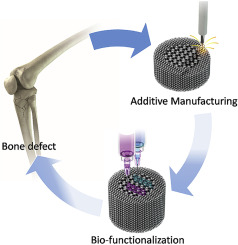Journal of the Mechanical Behavior of Biomedical Materials ( IF 3.3 ) Pub Date : 2020-02-06 , DOI: 10.1016/j.jmbbm.2020.103671 Jun Li 1 , Xiaolin Cui 1 , Gary J Hooper 1 , Khoon S Lim 2 , Tim B F Woodfield 2

|
Evolution of metallurgy and biomaterials has progressively shifted the focus of metallic bone-interfacing implant design from adequate mechanical strength and biocompatibility to rapid osseointegration and infection inhibition. The now relatively well-established technology – powder bed additive manufacturing (AM), offers the ability to fabricate porous implants with precise mechanical properties, topological pore architectures and patient-specific design functions, has revolutionized the production of customized multifunctional metallic implants for the individual patient with anatomic-specific requirement. Even though AM titanium and its alloy Ti–6Al–4V have been investigated and adopted for clinical application for decades, the development of porous AM titanium implants is far from complete and further research is required to achieve excellent long-term clinical performance. In this review, we summarize the current status of AM in bone-interfacing implant fabrication, with particular focus on the experimental outcomes of various factors that influence osseointegration, bone and vascular ingrowth as well as hybrid strategies to combat infection, including: pore size, porosity, pore structure, surface modification techniques and incorporation of biological factors. In addition, we also discuss the osteogenic capacity of constructs fabricated through different manufacturing methods and titanium alloys. To this end, we highlight the exciting prospect of AM for bone-interfacing implant manufacture through optimization via material development, implant design, bio-functionalization to clinical evaluation to provide enhanced patient specificity and long-term function.
中文翻译:

混合添加剂制造的用于骨科应用的钛植入物的合理设计,生物功能化和生物性能:综述。
冶金和生物材料的发展已逐渐将金属骨界面植入物设计的重点从足够的机械强度和生物相容性转移到了快速的骨整合和感染抑制。现在相对成熟的技术–粉末床增材制造(AM),具有制造具有精确机械性能,拓扑孔结构和患者特定设计功能的多孔植入物的能力,彻底改变了为个人定制的多功能金属植入物的生产方法有解剖学特定要求的患者。尽管AM钛及其合金Ti–6Al–4V已被研究并已用于临床数十年,多孔AM钛植入物的开发远未完成,需要进一步的研究以实现出色的长期临床表现。在这篇综述中,我们总结了AM在骨界面植入物制造中的现状,特别关注影响骨整合,骨骼和血管向内生长的各种因素以及对抗感染的混合策略的实验结果,包括:孔径,孔隙率,孔结构,表面改性技术以及生物因素的结合。此外,我们还讨论了通过不同制造方法和钛合金制造的构造物的成骨能力。为此,我们将通过材料开发,植入物设计,











































 京公网安备 11010802027423号
京公网安备 11010802027423号